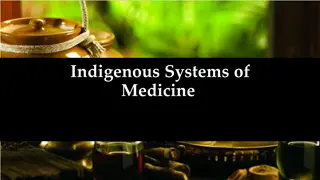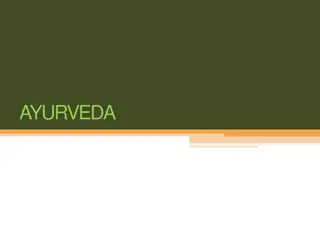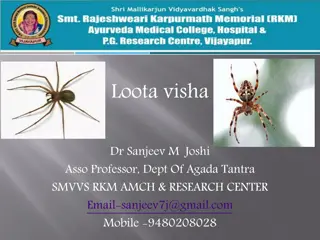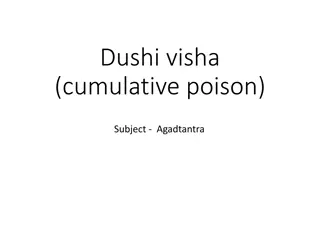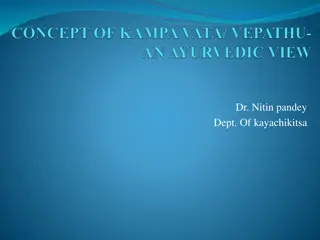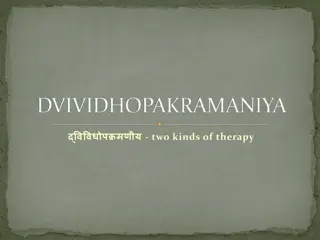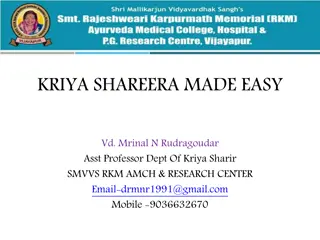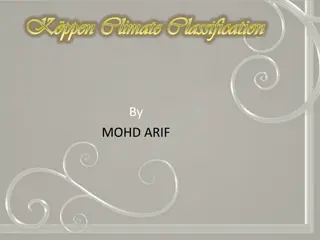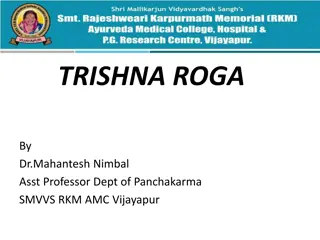Understanding the Classification of Kustha in Ayurveda
The classification of Kustha, a term used in Ayurveda for skin diseases, is based on various factors such as Dosha predominance, Dhatu involvement, and clinical features. Kustha can be categorized into different types like Vataja, Pittaja, Kaphaja, and based on its penetration into specific Dhatus. This classification helps in understanding the nature of the skin disorder and guides treatment approaches.
Download Presentation

Please find below an Image/Link to download the presentation.
The content on the website is provided AS IS for your information and personal use only. It may not be sold, licensed, or shared on other websites without obtaining consent from the author. Download presentation by click this link. If you encounter any issues during the download, it is possible that the publisher has removed the file from their server.
E N D
Presentation Transcript
Kustha Dr. Pravin Kumar Rai Associate Professor Department of Kayachikitsa Himalayiya ayurvedic Medical college and Hospital, Dehradun
Classification of Kustha Basis of classification includes Dosha Arambhata Uttarottar Dhatu Anupraveshata Lakshanas (Clinical features) Sadhyata (Prognosis)
On the basis of Dosha predominanace: On the basis of Dosha predominance Kushtha can be grouped into three categories Vataja Pittaja and Kaphaja Tridosaja
On the basis of Dhatugatatva Kushtha can be classified into seven categories on the basis of penetration in the particular Dhatu, which is as follows: 1. Rasagata 2. Raktagata 3. Mansagata 4. Medagata 5. Asthigata 6. Majjagata 7. Shukragata
CLASSIFICATION OF KUSTHA Mahakushtha Kshudrakushtha Bahu Dosha Arambhata Alpa Dosha Arambhata Bahu Lakshana Alpa Lakshana Excessive discomfort Less discomfort Penetrates into deeper Dhatus Less tendency to penetrate in deeper Dhatus Mahat Chikitsa Alpa Chikitsa
Maha Kustha and dosa predominance Charak Sushruta Vagbhata Kapal - Vata Arun - Vata Kapal - Vata Udumbara - Pitta Audumber - Pitta Udumber - Pitta Mandal - Kapha Rishyajihva - Pitta Mandal Kapha Rishyajihva Vata- Pitta Kapal Pitta Dadru Kapha-Pitta Pundrika Pitta- Kapha Kakanaka Pitta Kakanak Vata-Pitta-Kapha Sidhma Vata- Kapha Pundrika Kapha Pundrik Kapha-Pitta Kakanak Vata-Pitta-Kapha Dadru Kapha Rishyajihva Vata-Pitta
Kshudra Kustha Charak Sushruta Vagbhata Ek Kustha - V K Arushk - K Ek Kustha - V K Charmakustha V K Sidhma K Charma Kustha V K Kitibha V K Raksa K Kitibha V K Vipadika V K Mahakustha K Vipadika V K Alasak V K Ek Kustha K Alasa V K Dadru PK Parisarp V Sidhma V K Charmadala PK Visarp P Charmadala K P Pama P K Kitibha - P Pama K P Visphota PK Vicharchika - P Shataru K P Shataru PK Pama P Vicharchika K Vicharchika K Charmadala P Visphota K P
POORVA RUPA POORVA RUPA Li'kkZKRoefrLosnks u ok oSo.;ZeqUufrA dksBkuka ykseg"kZ'p d.MwLrksn% Je% Dye%AA oz.kkukef/kda 'kwya 'kh?kzksRifRrf'pjfLFkfr%A nkg% lqIrrk psfr dq"By{k.kexzte~AA p0fp0 7@11&12
Roopa Maha Kustha: 1. Kapala: That which is black and reddish piece of earthen jar with rough course, thin and excessively painful is known as kapala Kustha. It is hardly curable. 2. Audumbara: The type of Kustha which is associated with burning sensation, itching, pain and redness, brown skin hairs and similar to (ripe) fruit of udumbara is known as Audambara Kustha. 3. Mandala: White stable unctuous with raised patches and joined together is mandala Kustha. It is difficult to cure. 4. Rishyajihba: That which is rough, with red margins, internally blackish, painful and similar to the tongue of rishya (a type of antelope).
5. Pundarika: That which is whitish, with red margins, raised resembling lotus petals and with burning sensation is known as Pundarika Kustha. 6. Sidhma: That which is white, coppery and thin, leaves out dust like powder on rubbing and stimulates flowers of bottle groud is known as sidhma Kustha. It appears mostly on chest. 7. Kakanaka: That which stimulates gunja seeds in colour does not suppurate and is excessively painful is kakana Kustha.
Kshudra Kustha Eka Kustha: Eka Kustha is characterized by absence of perspiration, extensive localization and resembles the scales of fish. Charma Kustha: Charma Kustha, the skin becoming thick like that of an elephant skin is seen. Kitibha Kustha: Kitibha type of Kustha is characterized by blackish brown in colour. It is rough in touch like a scar tissue and it is hard to touch. It produces itching sensation also. Vipadika Kustha: Vipadika type of Kustha is associated with cracks in palms & soles of feet as well as excruciating pain.
Alasaka Kustha: Alasaka type of Kustha is characterized by nodular growth associated with excessive itching sensation and redness. Dadru Kustha: Dadru is characterized by itching sensation, redness, pimples and circular patches with elevated edges. Charmadala Kustha: Is red associated with itching, eruptions and has tenderness. Pama Kustha: Pama is characterized by excessive itching eruptions which are white, reddish or blackish brown in colour.
Visphota Kustha: This is characterized by pustules which are either white or reddish in appearance; these pustules have a thin skin. Shataru Kustha: It is red or blackish, associated with burnibng sensation and pain and consisting of multiple boils. Vicharchika Kustha: It is itchy consists of pimples, is blackish with excessive discharge.
Clinical features of Kushtha according to the Dosha predominance Vataja Kushtha: Skin lesions are rough, dry, reddish black and associated with pain. Vataja Kushtha is also characterizes by stretching of skin, numbness, anhydrosis, swelling and hoarseness of voice. Pittaja Kushtha : It is associated with burning, erythema, secretions and blister formation. Also characterizes by pustulisation, removal of dead tissues from fingers, nose, ears etc. and super infections. Kaphaja Kushtha : Skin lesions are cold and dense and associated with itching, secretions, discolouration and heaviness of the body.
jkS{;a 'kks"kLrksn% 'kwya ladkspua rFkk;ke%A ik:";a [kjHkkoks g"kZ% ';ko:.kRoa pAA dq"Bs"kq okrfy nkgksjkx% ifjJo% ikd%A foL=ks xU/k% DysnLrFkk xirua p fi kd`re~AA 'oSR;a 'kSR;a d.Mw% LFkS;Z pksRls/kxkSjoLusgk%A dq"Bs"kq rq dQfy tUrqfHkjfHkHk{k.ka Dysn%AA p0l0fp0 7@34&36
The clinical presentation of Kushtha according to the penetration in the particular Dhatu Tvakagata or Rasagata Kushtha: Characterizes by loss of sensation, excess sweating, mild itching, discolouration and dryness. Raktagata Kushtha: It is characterizes by numbness, goose flesh, excess sweating, itching and pus formation. Mansagata Kushtha : Characterizes by general body swelling, appearance of stable nodules, pricking pain and cracking of skin.
Medagata Kushtha : Medogata Kushtha is associated with Durgandha, Malavraddhi, pus formation, super infection and general bodyache. Asthi and Majja Gata Kushtha: Such type of Kushtha is characterizes by redness of eyes, super infected ulcers and hoarseness of voice. Shukragata Kushtha : It is characterizes by deformities in fingers, reduced movement of body parts, general bodyache and appearance of fast spreading ulcers. It is also characterizes by inheritance of Kushtha Roga to the next generation.
SADHYATA / ASADHYATA (PROGNOSIS) Sadhya : involvement of single Dosha, Vata-Kapha predominant Kushtha and Rasagata, Raktagata and Mansagata Kushtha is easily curable. Krichasadhya: Vata-Pitta Pitta-Kapha, predominant Kushtha and Medagata Kushtha have some bad prognosis and are difficult to cure. Asadhya: The Kushtha Roga with involvement of all three Doshas, the patient is weak and having thirst & burning, associated with Krimi and Asthi, Majja and Shukragata Kushtha have very bad prognosis and are incurable



